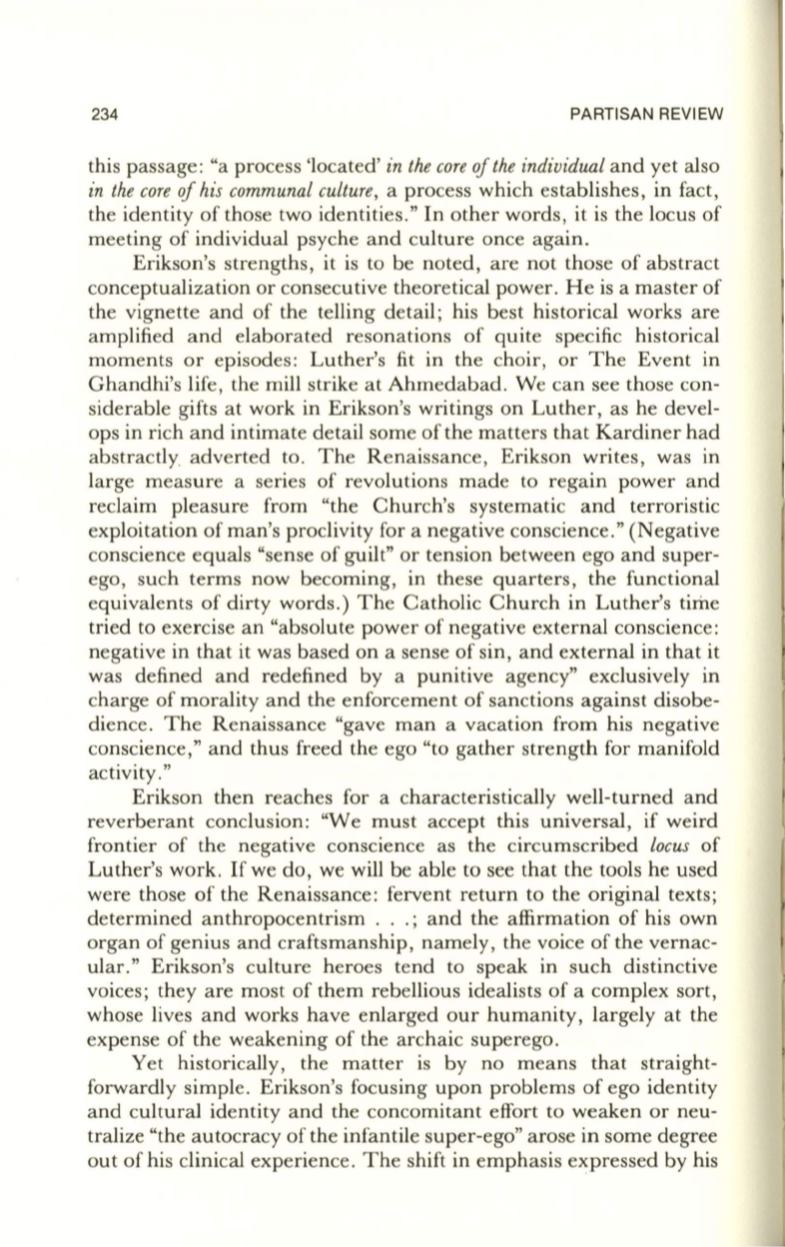
234
PARTISAN REVIEW
this passage: "a process 'located'
in the core of the individual
and yet also
in the core
of
his communal cuLture,
a process which establishes, in fact,
the identity of those two identities." In other words, it is the locus of
meeting of individual psyche and culture once again.
Erikson's strengths, it is to be noted, are not those of abstract
conceptualization or consecutive theoretical power. He is a master of
the vignette and of the telling detail ; his best historical works are
amplified and elaborated resonations of quite specific historical
moments or episodes: Luther's fit in the choir, or The Event in
Ghandhi's life, the mill strike at Ahmedabad. We can see those con–
siderable gifts at work in Erikson's writings on Luther, as he devel–
ops in rich and intimate detail some of the matters that Kardiner had
abstractly adverted to . The Renaissance, Erikson writes, was in
large measure a series of revolutions made to regain power and
reclaim pleasure from "the Church's systematic and terroristic
exploitation of man's proclivity for a negative conscience." (Negative
conscience equals "sense of guilt" or tension between ego and super–
ego, such terms now becoming, in these quarters, the functional
equivalents of dirty words.) The Catholic Church in Luther's time
tried to exercise an "absolute power of negative external conscience:
negative in that it was based on a sense of sin, and external in that it
was defined and redefined by a punitive agency" exclusively in
charge of morality and the enforcement of sanctions against disobe–
dience. The Renaissance "gave man a vacation from his negative
conscience," and thus freed the ego "to gather strength for manifold
activity."
Erikson then reaches for a characteristically well-turned and
reverberant conclusion: "We must accept this universal, if weird
frontier of the negative conscience as the circumscribed
locus
of
Luther's work.
If
we do, we will be able to see that the tools he used
were those of the Renaissance: fervent return to the original texts;
determined anthropocentrism . . .; and the affirmation of his own
organ of genius and craftsmanship, namely, the voice of the vernac–
ular." Erikson's culture heroes tend to speak in such distinctive
voices; they are most of them rebellious idealists of a complex sort,
whose lives and works have enlarged our humanity, largely at the
expense of the weakening of the archaic superego.
Yet historically, the matter is by no means that straight–
forwardly simple. Erikson's focusing upon problems of ego identity
and cultural identity and the concomitant effort to weaken or neu–
tralize "the autocracy of the infantile super-ego" arose in some degree
out of his clinical experience. The shift in emphasis expressed by his


